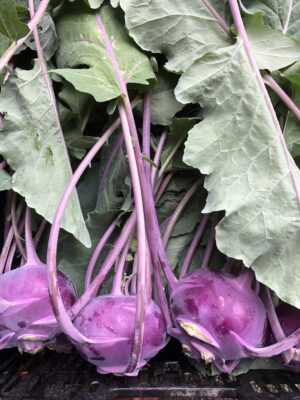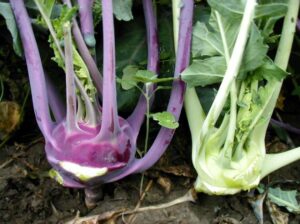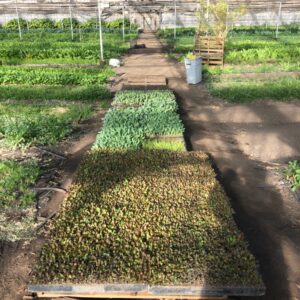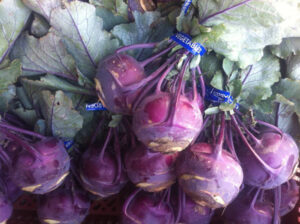Kohlrabi Rising

The humble kohlrabi and anoint it as the next “it” vegetable. Why not? Kale got the “celebuveggie” treatment and kale salads sprouted up on menus from Malibu to Muskogee! I’m not the world’s biggest kale salad fan, despite being a kale grower, because I think the texture is a bit much, and when I make a “kale salad” I prefer to use spigariello, but kohlrabi greens would work too, and they’re both a lot more tender on the tongue than kale.
 Kale, spigariello, and kohlrabi are all members of the Brassica oleracea group- along with collards, cabbage, broccoli, Brussels sprouts, and cauliflower. Brassica oleracea is a star among vegetables. When you see them growing together you can see how they’re all family, but they look diverse from a distance. With kale and spigariello it’s the leaves that are valued, but cauliflower’s inner, more tender leaves can be cooked with good results. With cabbage and Brussels sprouts we’re still eating the leaves, but they grow curling inward to form heads and don’t open outwards into a rosette like the kales, collards and spigariello. With Broccoli and cauliflower we’re eating the emergent, immature flower buds. But with kohlrabi we focus on the bulbous, swollen stem, which looks round, like a turnip that is on top of the ground, but the leaves are good food, and if you let the plant go to flower the floral buds could be consumed like tiny broccolis. All the members of the Brassica oleracea are so closely related that they can cross-pollinate like dogs into myriad mongrel forms.
Kale, spigariello, and kohlrabi are all members of the Brassica oleracea group- along with collards, cabbage, broccoli, Brussels sprouts, and cauliflower. Brassica oleracea is a star among vegetables. When you see them growing together you can see how they’re all family, but they look diverse from a distance. With kale and spigariello it’s the leaves that are valued, but cauliflower’s inner, more tender leaves can be cooked with good results. With cabbage and Brussels sprouts we’re still eating the leaves, but they grow curling inward to form heads and don’t open outwards into a rosette like the kales, collards and spigariello. With Broccoli and cauliflower we’re eating the emergent, immature flower buds. But with kohlrabi we focus on the bulbous, swollen stem, which looks round, like a turnip that is on top of the ground, but the leaves are good food, and if you let the plant go to flower the floral buds could be consumed like tiny broccolis. All the members of the Brassica oleracea are so closely related that they can cross-pollinate like dogs into myriad mongrel forms.

Lettuce and kohlrabi trays in the greenhouse, ready to transplant out.
I love kohlrabi because the fat, round stem is sweet and crunchy like jicama. Kohlrabi can be cooked- steamed or cubed and stir fried, or grated and folded into latkes or dressed as coleslaw, but I usually just eat it raw, sliced and dressed with a little Meyer lemon juice. I’ve grown both purple kohlrabi and green kohlrabi and come to the conclusion that the purple form is consistently sweeter than the green variety, so that’s what you’re getting today. Later in the season we’ll harvest a super large sized green kohlrabi variety that is popular in Germany and I’ll be excited to try it because I’ve never grown it before. The seed is expensive so I’ve got it sprouting under cover in trays in the greenhouse for transplant later instead of being sown directly in the ground where it would be in danger of being pecked up by birds. The large form of kohlrabi will be ready for transplant in a month or so, and harvest will commence in May when warm weather will make crisp, crunchy salads very appealing.
 Kohlrabi was developed in Northern Europe and is most commonly associated with German, Dutch and Scandinavian cuisine, but the crop has found an unlikely home in the cooking of Northern India and Nepal. Colonial powers introduced the plant to India and farmers there found that the crop did well for them because the plump, crisp ball of a swollen stem that makes up the best portion of the plant rests on top of the ground, and not in the ground, like a turnip, so it is less susceptible to damage from pests like nematodes that live in the soil. If you strip the leaves off the ball so that the plant doesn’t continue to transpire after harvest- and thus wilt- and if you keep the harvest in a cool place they will “keep” for a long time. You’re not going to want to keep the kohlrabi that you get in you box for long though. They’re going to taste so good you’ll gobble them up and wonder why I didn’t send you more. Don’t worry; I’m working on it.
Kohlrabi was developed in Northern Europe and is most commonly associated with German, Dutch and Scandinavian cuisine, but the crop has found an unlikely home in the cooking of Northern India and Nepal. Colonial powers introduced the plant to India and farmers there found that the crop did well for them because the plump, crisp ball of a swollen stem that makes up the best portion of the plant rests on top of the ground, and not in the ground, like a turnip, so it is less susceptible to damage from pests like nematodes that live in the soil. If you strip the leaves off the ball so that the plant doesn’t continue to transpire after harvest- and thus wilt- and if you keep the harvest in a cool place they will “keep” for a long time. You’re not going to want to keep the kohlrabi that you get in you box for long though. They’re going to taste so good you’ll gobble them up and wonder why I didn’t send you more. Don’t worry; I’m working on it.
© 2021 Essay and Photos by Andy Griffin.


